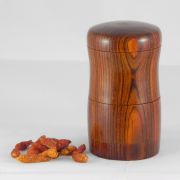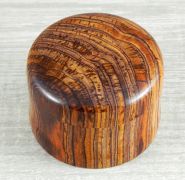Recent models
Mes Moulins - My Peppermills
Why ‘my mills‘? It starts with the choice of the model meaning the size, form, kind of wood, perhaps my specific mood of the day or having something special in mind, whatever. In any event, the choice of a mill is something personal, connected to my aesthetic sensations, something I find appealing and pleasing to my senses.
Last, but not least, ‘my mills’ is here to improve my food, please my eyes and delight my olfaction and palate. The wood with its finish gives me a haptic impression and I can hear the grinding of the pepper. Yes, a mill is an instrument that talks to all my senses.
Which wood?
The wood for a mill could be light or dark, local or exotic. A given piece of wood dictates the size and form of the mill. Other considerations are: where will I mainly use it – at the table or in the kitchen and how many or which mills will I have – pepper, salt, chili, or nutmeg.
The choice of wood also influences the possible form of the mill. Example: Plum is truly beautiful, however, the material available isn’t large in size and consequently it isn’t possible to produce a large mill. If a large mill is desired, one needs to resort to wood from trees that have bigger trunks, e.g., cherry, apple, walnut or olive.
Plum serves also as a good example for another consideration: this kind of wood often comes with cracks. Planks and pieces commercially available aren’t thick because the bigger the size the bigger the danger for the wood to crack. As a result, there is hardly any plum wood available that doesn't have cracks. That’s also the reason you rarely will find furniture built with it. However, when turning wood those cracks contribute to the individual character of the piece if the cracks had been closed professionally.
This way, a defect can turn into an aesthetic aspect – and thereby develops into a point of a beauty and interest. read more about material >>









